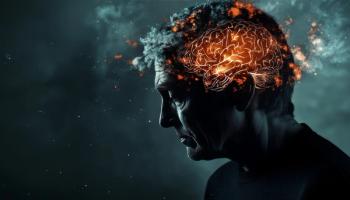
Sleep Disturbances in Individuals at Ultra-High Risk of Psychosis
Researchers investigated sleep disturbances in individuals at ultra-high risk of psychosis.
CASE VIGNETTE
“William” is a 17-year-old male in the eleventh grade who is being evaluated by his school psychologist for declining academic performance. Last year, his grades were all As and Bs, but this year he has mostly Cs, with 1 D in an advanced math class. William has no active medical problems and has never seen a psychiatrist.
He reports that he has had trouble sleeping over the past few months. He says he is in bed for approximately 8 hours per night and typically has 1 to 2 nocturnal awakenings. He reports feeling exhausted upon awakening in the morning, and his mother reports significant difficulties in waking him up for school. William does not currently use tobacco, alcohol, or illicit drugs, but admits to trying marijuana once at a party in the past year. There is no history of abuse. He has a paternal uncle with schizoaffective disorder.
On interview, William’s affect is slightly restricted, but it brightens when he talks about his hobby, computer programming. He reports hearing whispering voices on a few occasions at night, which he has attributed to noises outside his bedroom window. He reports that it has been harder for him to concentrate at school during this academic year because he always feels tired. His mother is concerned about his sleep problems and inquires if a sleep study is warranted.
The Current Study
Nordholm and colleagues5 investigated subjective and actigraphy-measured sleep disturbances and melatonin levels in individuals at ultra-high risk for psychosis (UHR) and controls. This subject was a secondary analysis of the larger Function and Overall Cognition in Ultra-high risk States (FOCUS) trial.6 Inclusion criteria were that participants must be aged 18 to 40 years and fulfill UHR criteria according to the Comprehensive Assessment of At-Risk Mental State (CAARMS) criteria.7
Participants were recruited from outpatient and inpatient psychiatric facilities in Copenhagen and were randomized to either cognitive remediation or standard therapy. Participants had follow-up assessments at 6 and 12 months after baseline. Community controls were recruited by internet advertising and local educational institutions. Controls did not have a personal history of any DSM-IV disorder, nor a first-degree relative with a psychotic disorder. UHR and control individuals were matched on age, sex, ethnicity, and parental socioeconomic status.
Attenuated psychotic symptoms were measured with the CAARMS. All individuals completed a sleep diary and a modified version of the Karolinska Sleep Questionnaire. Data from wrist actigraphy for 24 hours were also collected. All participants also collected saliva samples immediately after awakening and at bedtime, which were used to measure melatonin levels. Between-group differences were assessed using independent samples t-test or chi-square test. Linear regression analyses were performed for associations between CAARMS composite score, melatonin, and sleep indices in UHR individuals.
The authors included 72 UHR individuals and 36 controls. Seventy of the UHR individuals fulfilled the attenuated psychotic symptoms criteria, and 23 fulfilled the state and trait risk factor criteria. Controls were significantly more likely to report sleeping 7 or 8 hours per night over the past 4 weeks, whereas more UHR individuals reported sleeping 9 hours or more per night. UHR individuals reported significant more disturbed sleep and problems with awakening than controls. There were no significant differences in awakening time, actigraphy measures, or melatonin levels between UHR and control groups.
In UHR individuals, a higher CAARMS composite score was associated with a higher self-reported awakening index and higher melatonin at awakening. By contrast, the CAARMS composite score was not associated with the disturbed sleep index, evening melatonin, or actigraphy measures.
Study Conclusions
The authors concluded that UHR individuals had higher levels of subjectively reported sleep disturbances than controls, but the groups did not differ based on objective measures of sleep (actigraphy) or melatonin levels. More attenuated psychotic symptoms were associated with a higher awakening index and higher melatonin at awakening.
Study strengths include the use of an objective measure of sleep (actigraphy) and a validated instrument to assess subjective sleep (Karolinska Sleep Questionnaire). Study limitations include the fact that actigraphy was only worn for 1 night and melatonin was only collected over 1 day, whereas subjective ratings of sleep were based on the past 4 weeks. Data on daytime sleep behaviors (eg, napping) was not reported, which could have contributed to nighttime sleep disturbance.
The Bottom Line
UHR individuals have higher subjective, but not objective, sleep symptoms. The CAARMS composite score was associated with a high awakening index and morning melatonin level in UHR individuals. Evaluation of sleep in this population, which may impact on risk of conversion to psychosis, is warranted.
Dr Miller is a professor in the Department of Psychiatry and Health Behavior at Augusta University in Augusta, Georgia. He is on the Editorial Board and serves as the schizophrenia section chief for Psychiatric Times®. The author reports that he receives research support from Augusta University, the National Institute of Mental Health, and the Stanley Medical Research Institute.
References
1. Clarke L, Chisholm K, Cappuccio FP, et al.
2. Freeman D, Taylor KM, Molodynski A, Waite F.
3. Reeve S, Emsley R, Sheaves B, Freeman D.
4. Lunsford-Avery JR, LeBourgeois MK, Gupta T, Mittal VA.
5. Nordholm D, Jensen MA, Glenthøj LB, et al.
6. Glenthøj LB, Mariegaard LS, Fagerlund B, et al.
7. Yung AR, Yuen HP, McGorry PD, et al.
Newsletter
Receive trusted psychiatric news, expert analysis, and clinical insights — subscribe today to support your practice and your patients.














